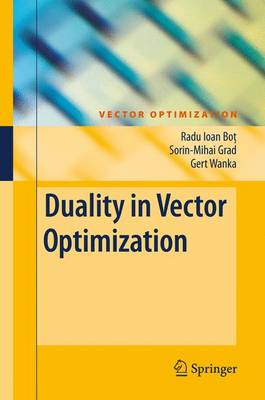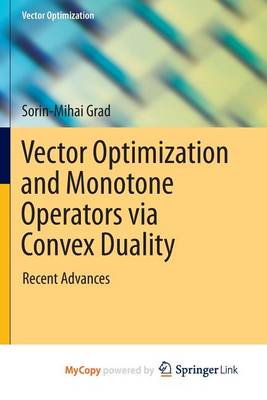Vector Optimization
2 total works
Duality in Vector Optimization
by Radu Ioan Bot, Sorin-Mihai Grad, and Gert Wanka
Published 15 August 2009
Thecontinuousandincreasinginterestconcerningvectoroptimizationperc- tible in the research community, where contributions dealing with the theory of duality abound lately, constitutes the main motivation that led to writing this book. Decisive was also the research experience of the authors in this ?eld, materialized in a number of works published within the last decade. The need for a book on duality in vector optimization comes from the fact that despite the large amount of papers in journals and proceedings volumes, no book mainly concentrated on this topic was available so far in the scienti?c landscape. There is a considerable presence of books, not all recent releases, on vector optimization in the literature. We mention here the ones due to Chen,HuangandYang(cf. [49]),EhrgottandGandibleux(cf. [65]),Eichfelder (cf. [66]), Goh and Yang (cf. [77]), G.. opfert and Nehse (cf. [80]), G.. opfert, - ahi, Tammer and Z? alinescu (cf. [81]), Jahn (cf. [104]), Kaliszewski (cf. [108]), Luc (cf. [125]), Miettinen (cf. [130]), Mishra, Wang and Lai (cf. [131,132]) and Sawaragi, Nakayama and Tanino (cf. [163]), where vector duality is at most tangentially treated. We hope that from our e?orts will bene?
t not only researchers interested in vector optimization, but also graduate and und- graduate students. The framework we consider is taken as general as possible, namely we work in (locally convex) topological vector spaces, going to the usual ?nite - mensional setting when this brings additional insights or relevant connections to the existing literature.
t not only researchers interested in vector optimization, but also graduate and und- graduate students. The framework we consider is taken as general as possible, namely we work in (locally convex) topological vector spaces, going to the usual ?nite - mensional setting when this brings additional insights or relevant connections to the existing literature.
Vector Optimization and Monotone Operators Via Convex Duality
by Sorin-Mihai Grad
Published 1 January 2014
This book investigates several duality approaches for vector optimization problems, while also comparing them. Special attention is paid to duality for linear vector optimization problems, for which a vector dual that avoids the shortcomings of the classical ones is proposed. Moreover, the book addresses different efficiency concepts for vector optimization problems. Among the problems that appear when the framework is generalized by considering set-valued functions, an increasing interest is generated by those involving monotone operators, especially now that new methods for approaching them by means of convex analysis have been developed. Following this path, the book provides several results on different properties of sums of monotone operators.

